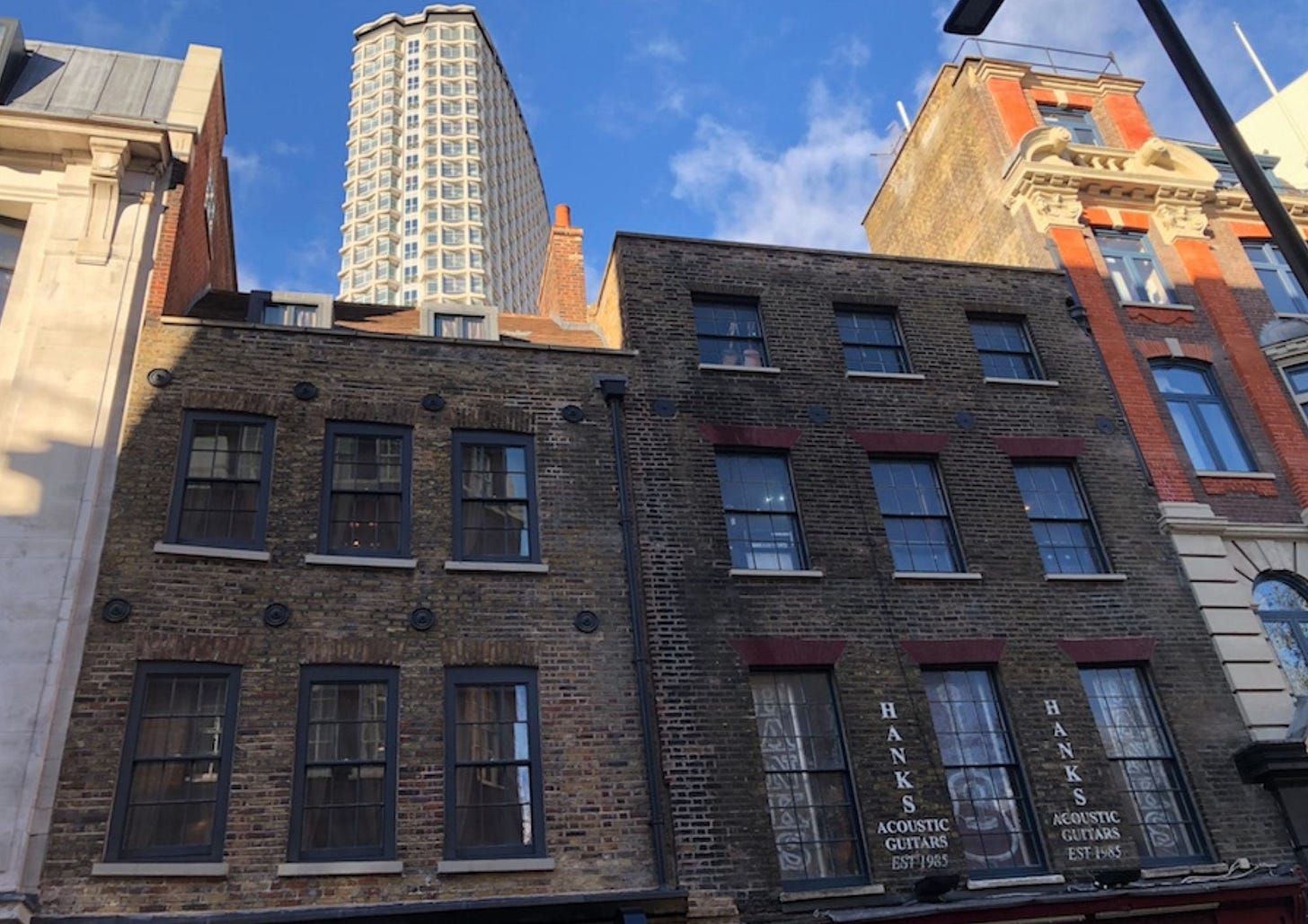Tin Pan Alley and the 12 Bar blues
Developers say they have improved Denmark Street but has the famous music mecca lost its bohemian vibe?
Hello everyone. We’ve had a little burst of new subscribers on both free and unpaid plans this week, so we’d like to say thanks for the mentions to London Centric and the London Minute. Check them both out. This week’s deep dive feature takes us to the very south of Camden as Dan Carrier speaks to guitar traders and other businesses who feel frozen out of the redevelopment of Denmark Street – the heritage stretch better known as Tin Pan Alley. It’s all change down there, but has it lost its indie spirit?
Look out for our politics column, the North London Bubble, later this weekend and all free subscribers will get our news digest on Monday. Also, look out for print editions which include Tom Foot’s exclusive on Highgate School burying a 200-year-old human skeleton it once used for biology lessons.
If you are new, bonus NewJournal+ features you may have missed include Tom revealing who stole a priceless Vermeer from Kenwood in 1974, the gamble local authorities are taking to try and stem the flow of new bookmakers by Daisy Clague and Dan’s interview with the founder of Camden Market.
Thanks as ever for your support.
THERE was once only one place to go if you had a guitar dream, a street with such cultural fame it ceased being called by its real name and was instead known by a far more evocative nickname.
Officially, this is Denmark Street, tucked away behind Centre Point, but its stretch of music shops frequented by everyone from novices to the best in the business took on the mantle as being Britain’s Tin Pan Alley.
For many years, record labels had offices and studios above the stores: the Rolling Stones cut tracks here, while the road became a meeting cross for creatives, the like of Sir Elton John and David Bowie would be seen in the Gioconda coffee bar on their way to fame.
It’s where I first met Andy Preston who ran Andy’s Guitars, one of the shops that would attract little groups of teenagers on Saturday afternoons. They had no money to spend but would always ask to have a go on the guitars hanging on the wall.
It’s an urban myth, perpetuated by the film Wayne’s World, that these youngsters would badly pick out the opening notes to Led Zep’s Stairway to Heaven. The long-suffering staff in the shops will tell you that they actually had to listen to Smoke On The Water, House of the Rising Sun or the opening riff to Layla, on repeat.
I had more of a thing for Chuck Berry and my first guitar, which cost a piggy-bank breaking £30, was a Japanese copy of the rock n roller’s famous Gibson 335. Mr Preston threw in a battered old hard case. I played it on the back seat of the top deck of the 134 bus home, pleased as punch.
Not only was he a guitar maker, seller, repairer and dealer who had moved in to Tin Pan Alley in the 1970s, but over the years Mr Preston had expanded and founded the 12 Bar Club next door for live performances.
It gave inexperienced acts the chance to play the instruments they had bought in Denmark Street, but would also have surprise appearances from established acts wanting to revel in a more intimate, basic setting.
Walk down Tin Pan Alley today and Andy’s Guitars isn’t there, nor is the club – and nor are some of those imperfect but enticing shops and studios that once made the street buzz. It has changed from those days of teenage window shopping for guitars I could never afford.
It has, many of the old traders say, been swamped by the redevelopment of St Giles which to their minds prioritises making as much money as possible for every inch and street corner in central London.
“We traders fought hard to protect it – and while there are some music shops back, they are not the dedicated independents that made the street what it was, and who were promised the right of return,” said Mr Preston.
So what happened to the old place?
Perhaps a lot can be traced back to the moment Crossrail was first mapped out in the early 2000s, the rail link slicing through London now known as the Elizabeth Line. Tottenham Court Road station was given a complete overhaul, which saw the much-loved venue, The Astoria, demolished.
The loss of the stage where all of music’s greats had played at least once was to be just the start of the facelift.
Developers Consolidated saw the opportunity. It was led by Laurence Kirschel, who had already been a key figure in how the West End has transformed.
His career began in an Oxford Street clothes shop but by the 1980s he came to the area as a developer amid a push to ‘clean up Soho’.
Its unpredictable mix of shabby and cosmopolitan could be a selling point, but others felt it wasn’t always edgy in a good way. With what planners call urban knitting, Soho landowners gradually introduced brands like Ed’s Diner and Caffè Nero into streets which had previously been home to a mish-mash of record shops, bohemian bars and adult book shops.
London saw the seams of the same urban knitting around St Giles Circus as dingy spots where the walls smelt of urine and people complained of drug debris were replaced with a new plaza designed by Renzo Piano which opened the door to familiar chain restaurants and offices for tech firms – and a bit of housing too.





